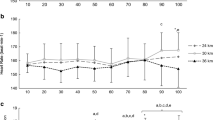Abstract
The aim of this study is to establish whether the introduction of an exercise bout of different distance, would affect the retention of the pacing schema stored from a prior exercise bout. Furthermore, to identify whether the ‘internal clock’ can be calibrated to absolute distance, and whether this is disrupted by exercise requiring a different pacing strategy. Sixteen highly trained male cyclists were randomly allocated into a control (CON) or experimental group (EXP) and completed four time trials (TT) of two different distances (2 × 4 km and 2 × 6 km), separated by 17 min. The participants in the CON group completed both distances in a sequential order whereas the EXP group completed both distances in a variable order. No significant differences in completion time or mean PO were observed (p > 0.05). The CON group showed a significant improvement in their estimation of distance completed in both the 4 km (24.6 ± 18.2 vs. 8.2 ± 5.5%) and 6 km (15.2 ± 7 vs. 8.6 ± 3%) distances (t 7 = 2.791, t 7 = 3.118, p < 0.05). No significant differences in distance estimation were observed in the EXP group (p > 0.05). In conclusion, participants in the CON group displayed a significant improvement in their judgement of distance completed, despite no improvement in completion time. This suggests that a learned pacing schema is robust and not negatively affected by subsequent pacing variation. The internal clock shows an ability to be calibrated to absolute distance, although this does not improve performance.





Similar content being viewed by others
References
Abbiss CR, Laursen PB (2008) Describing and understanding pacing strategies during athletic competition. Sports Med 38(3):239–252
Albertus Y, Tucker R, St Clair Gibson A, Lambert EV, Hampson DB, Noakes TD (2005) Effect of distance feedback on pacing strategy and perceived exertion during cycling. Med Sci Sports Exerc 37(3):461–468
Atkinson G, Brunskill A (2000) Pacing strategies during a cycling time trial with simulated headwinds and tailwinds. Ergonomics 43(10):1449–1460
Borg G (1982) Perceived exertion as an indicator of somatic stress. Scand J Rehabil Med 2(2):92–98
Chaffin ME, Berg K, Zuniga J, Hanumanthu VS (2008) Pacing pattern in a 30-minute maximal cycling test. J Strength Cond Res 22(6):2011–2017
Davison RCR, Corbett J, Ansley L (2006) Influence of temperature and protocol on the calibration of the Computrainer electromagnetically braked cycling ergometer. In: British association of sport & exercise sciences annual conference, Wolverhampton, UK, p 12
Gibbon J, Church RM, Meck W (1984) Scalar timing in memory. In: Gibbon J, Allan L (eds) Timing and perception. New York Academy of Sciences, New York, pp 52–77
Hettinga FJ, De Koning JJ, Broersen FT, Van Geffen P, Foster C (2006) Pacing strategy and the occurrence of fatigue in 4000-m cycling time trials. Med Sci Sports Exerc 38(8):1484–1491
Lejeune H, Ferrara A, Simons F, Wearden JH (1997) Adjustment to changes in the time of reinforcement: peak interval transitions in rates. J Exp Psychol Anim Behav Proc 23:311–331
Mauger A, Jones A, Williams CA (2009) Influence of feedback and prior experience on pacing during a 4-km cycle time trial. Med Sci Sports Exerc 41(2):451–458
Noakes TD, St Clair Gibson A, Lambert EV (2005) From catastrophe to complexity: a novel model of integrative central neural regulation of effort and fatigue during exercise in humans: summary and conclusions. Br J Sports Med 39(2):120–124
St Clair Gibson A, Lambert EV, Rauch LH, Tucker R, Baden DA, Foster C, Noakes TD (2006) The role of information processing between the brain and peripheral physiological systems in pacing and perception of effort. Sports Med 36(8):705–722
Swart J, Lamberts RP, Lambert MI, Lambert EV, Woolrich RW, Johnston S, Noakes TD (2009) Exercising with reserve: exercise regulation by perceived exertion in relation to duration of exercise and knowledge of endpoint. Br J Sports Med 0:bjsm.2008.056036v1
Tucker R, Noakes TD (2009) The anticipatory regulation of performance: the physiological basis for pacing strategies and the development of a perception-based model for exercise performance. Br J Sports Med 43:393–400
Ulmer HV (1996) Concept of an extracellular regulation of muscular metabolic rate during heavy exercise in humans by psychophysiological feedback. Experientia 15 52(5):416–420
Ulmer HV, Schneider A, Neumahr S, Freitag W (1996) Precision of time and velocity estimation as a base of teleoanticipation. Pflügers Arch 431(Suppl R 48):1–5
Wearden JH (2004) Decision processes in models of timing. Acta Neurobiol Exp 64(3):303–317
Wilson JR, McCully KK, Mancini DM, Boden B, Chance B (1988) Relationship of muscular fatigue to pH and diprotonated Pi in humans: a 31P-NMR study. J Appl Physiol 64(6):2333–2339
Acknowledgments
No funding was received for the conduct of this study.
Author information
Authors and Affiliations
Corresponding author
Additional information
Communicated by Susan Ward.
Rights and permissions
About this article
Cite this article
Mauger, A.R., Jones, A.M. & Williams, C.A. Influence of exercise variation on the retention of a pacing strategy. Eur J Appl Physiol 108, 1015–1023 (2010). https://doi.org/10.1007/s00421-009-1308-y
Accepted:
Published:
Issue Date:
DOI: https://doi.org/10.1007/s00421-009-1308-y




